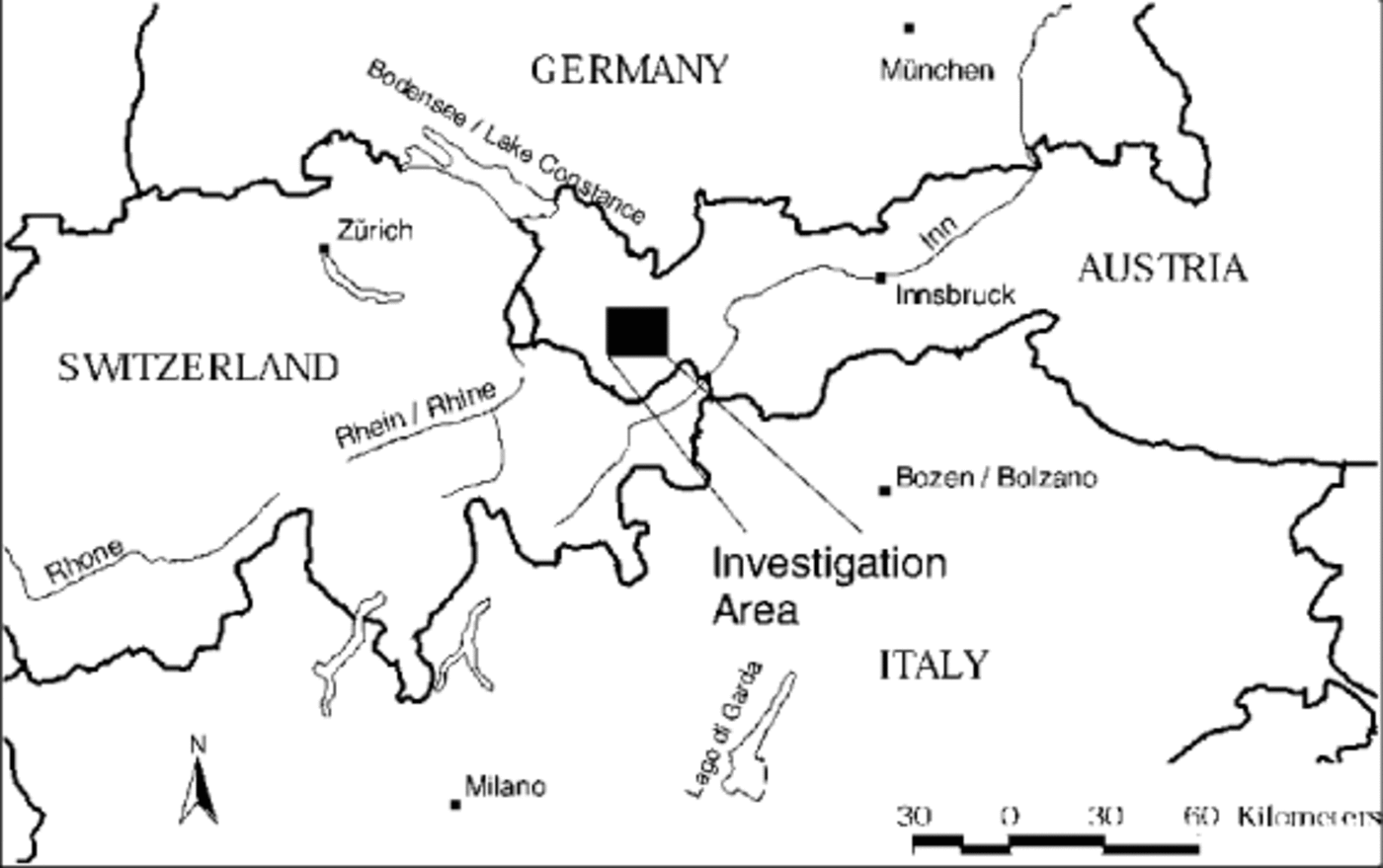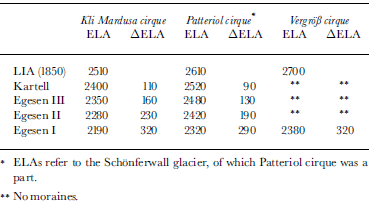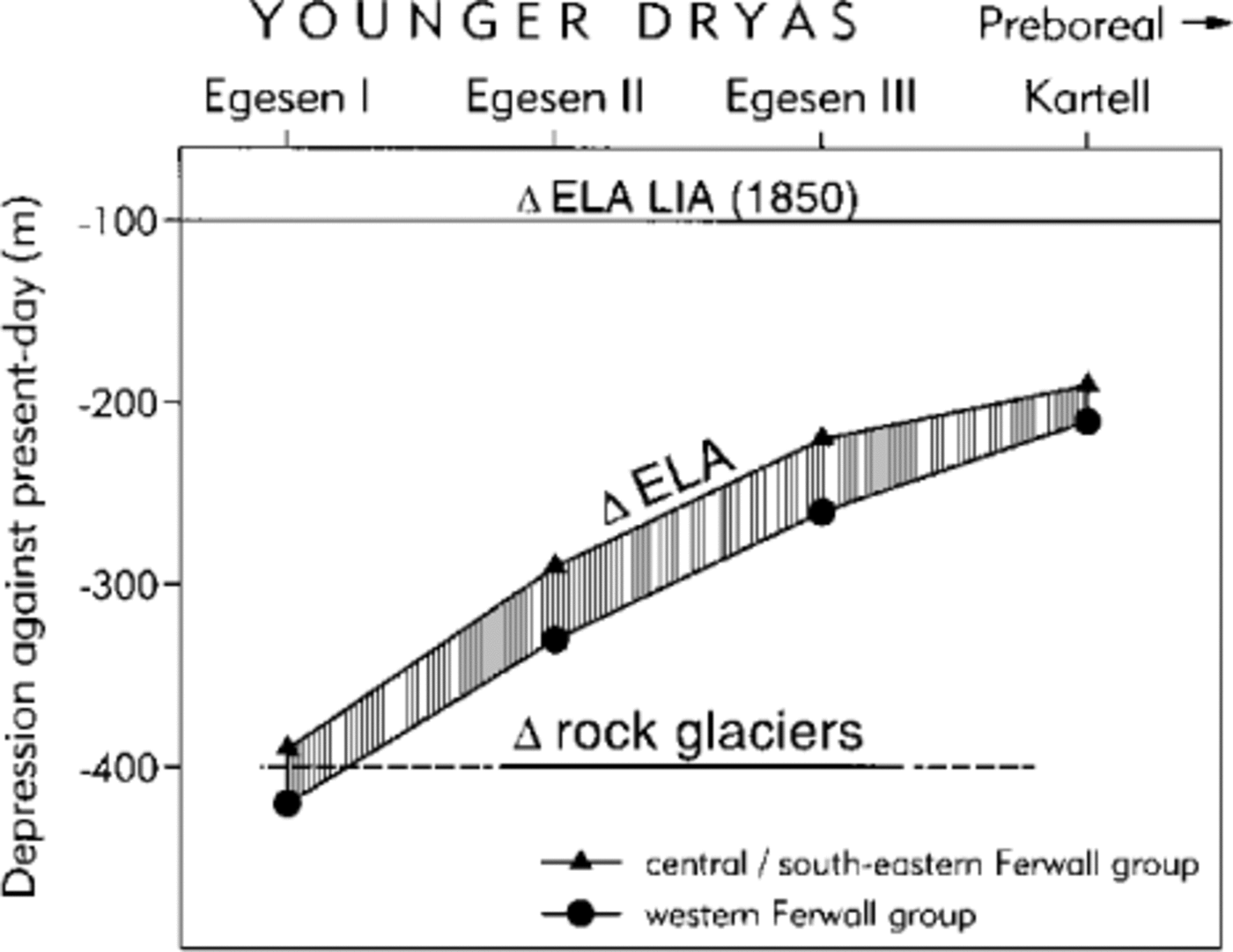Introduction
Late-glacial equilibrium-line altitudes (ELA) and rock- glacier altitudes are parameters which can be easily and accurately determined in wide areas of the Alps. They provide qualitative and quantitative information about the former climate in the Alpine valleys, because their distribution in space and time is predominantly controlled by climate. In this paper, an attempt is made to describe and discuss the fluctuations of the ELA and phases of rock-glacier development in the Ferwall group, western Tyrol, Austria, during theYounger Dryas cooling event.
The decay of the Alpine glaciers after the Last Glacial Maximum was interrupted by a series of several, successively smaller readvances (“stadials”). The moraine sequence is fairly consistent from valley to valley and has been extensively mapped in both the Austrian and Swiss Alps (e.g. Reference HeubergerHeuberger, 1966; Reference Mayr and HeubergerMayr and Heuberger, 1968; Reference KerschnerKerschner, 1978b; Maisch, 1981; Reference Muller, Kerschner and KuttelMuller and others, 1981; Reference SuterSuter, 1981; Reference Furrer, Burga, Gamper, Holzhauser and MaischFurrer and others, 1987 and references therein; Reference Ivy-Ochs, Schluchter, Kubik and BeerIvy-Ochs and others, 1995, Reference Ivy-Ochs, Schluchter, Kubik, Synal, Beer and Kerschner1996).
The moraines ofthe Egesen Stadial are the most marked and widespread of the series. In most valleys, three distinct series of moraines can be found (Egesen I to Egesen III). In some places, moraines of a fourth, slightly smaller advance (Kromer/Kartell) can be found. They represent the last cold event prior to the many advances of Holocene order of magnitude, which characteristically reached only the Little Ice Age (LIA) extent (e.g. Reference Patzelt and BortenschlagerPatzelt and Bortenschlager, 1973; Reference HolzhauserHolzhauser, 1984; Reference Patzelt and SchirmerPatzelt, 1995). Basal radiocarbon dates from peat bogs in the tongue areas of Egesen moraines in the Austrian Alps are in the late Younger Dryas—early Preboreal time range (Reference PatzeltPatzelt, 1972; Reference KerschnerKerschner, 1978b; Reference BortenschlagerBortenschlager, 1984). In the Val de Nendaz (southwestern Switzerland), the last phase of the Younger Dryas could be found by pollen analysis in lake deposits within the Egesen II moraine (Reference Muller, Kerschner and KuttelMuller and others, 1981). Surface-exposure ages of an Egesen I moraine atjulier pass (Switzerland) show it was deposited 200–300 years after the onset of theYounger Dryas (Reference Ivy-Ochs, Schluchter, Kubik, Synal, Beer and KerschnerIvy-Ochs and others, 1996). At the same locality, the activity of rock glaciers in connection with Egesen moraines continued into the early Preboreal. The Kromer/Kartell advance might be the correlative to the early Preboreal Erdalen event in western Norway (Reference Nesje and DahlNesje and Dahl, 1993; Reference Dahl and NesjeDahl and Nesje, 1996). Similar moraines in the Zugspitze Massif (southern Germany) are assumed to be of late Younger Dryas—early Preboreal age (Reference HirtlreiterHirtlreiter, 1992).
The Ferwall group is situated at the western margin of the central Alps in westernTyrol (Fig. 1). Crystalline bedrock (mainly gneisses, granites, amphibolites) favours the development and preservation of moraines and rock glaciers. Most peaks are in the range of2500–3000 m. From a climatic point of view, the western part of the Ferwall group, which is open towards the Rhine valley, is rather humid with precipitation values around 2000 mm a 1, whereas the eastern and southern part is somewhat drier (Reference Fliri and FraedrichFliri, 1975). This pattern is also reflected in the general rise of the present-day ELA from west to east (Reference GrossGross, 1983). Earlier work on the glacial geomorphology of the Ferwall group includes papers by Reference BobekBobek (1933), Reference Senarclens-GrancySenarclens-Grancy (1956) and Reference Fliri and FraedrichFraedrich (1979). A first paleoclimatic interpretation of Egesen moraines and associated rock glaciers in the Ferwall group was attempted by Kerschner (1978a).

Fig. 1. Study area.
Methods
The assignment of Alpine Late-glacial glaciers to a chrono-stratigraphy is based on:
-
(a) the relative position of the moraines within a moraine complex;
-
(b) the morphological appearance of the moraines; and
-
(c) depression rates of the ELA relative to a mean LIA (1850) ELA in the catchment area of the specific Late-glacial glacier.
In areas with crystalline bedrock, Egesen moraines usually do not show any evidence of solifluction overprint, but retain their fresh and sometimes rather blocky appearance. Older moraines at similar altitudes, which were deposited by glaciers of similar size (Daun Stadial), are much less distinct and were affected by solifluction in many places (Reference HeubergerHeuberger, 1966). Therefore, it is not difficult in the field to distinguish Egesen moraines from older moraines at altitudes above 1900–2000 m a.s.l.
Comparing the Younger Dryas ELAs with those of the LIA offers three advantages. First, it is possible to determine ELAs ofregions where no modern glaciers exist; second, it is possible to combine an inhomogeneously glaciated area to one decisive ELA; and third, the ELA of the LIA is an invariable quantity (Reference Gross, Kerschnerand and PatzeltGross and others, 1977; Reference MaischMaisch, 1992). In the study area, the ELA of the LIA was about 100 m lower than the “present-day” (i.e. Austrian Glacier Inventory, 1969: cf. Reference GrossGross, 1983) ELA.
To determine the ELA, two methods are commonly used. Where well-preserved lateral moraines can be found, the highest point of the moraine indicates the ELA of the specific glacier. But in most cases, the lack of well-preserved lateral moraines efforts the accumulation area ratio (AAR) method. The AAR in the Alps for Younger Dryas and modern glaciers is assumed to be 0.67. Both methods yield practically the same results (Reference Gross, Kerschnerand and PatzeltGross and others, 1977).
It is evident that a distinct rock-glacier formation occurred during the Egesen Stadial (Reference HeubergerHeuberger, 1966; Kerschner 1978a, Reference Kerschnerb). Kerschner (1978a) compared the beginning of the rock-glacier formation to the early Younger Dryas and correlated it with the Egesen I Stadial. One objective of this work is to test this hypothesis and to determine the time at which the rock glaciers formed.
Younger Dryas Glaciation
During the Younger Dryas, several valley glaciers and many cirque glaciers existed in the Ferwall group. Moraines of this region were previously assigned to older stadials (Reference BobekBobek, 1933; Reference Senarclens-GrancySenarclens-Grancy, 1956; Reference Fliri and FraedrichFraedrich, 1979), but recently Reference Sailer, Kerschner and HellerSailer and others (in press) have correlated these deposits to the Egesen Stadial.
As shown in Table 1, a northwest—southeast gradient of the LIA and Younger Dryas ELAs can be observed. This agrees well with modern observed ELAs. In the western part of the investigation area (Kli Mardusa cirque), the LIA ELA was at 2510 m; in the central part at 2610 m; and 2700 m in the southeast. The most extensive glaciation, showing “fresh” lateral and terminal moraines, can be correlated with the Egesen I advance with ELAs 320 m (west), 290 m (central) and 320 m (southeast) below the ELA of the LIA. These values are typical for the maximum of the Egesen Stadial (Reference KerschnerKerschner, 1978b; Reference MaischMaisch, 1982). In the Kli Mardusa cirque, the AAR method and the highest point of the Egesen I moraine lead to the same ELA.
Table 1. Little Ice Age (LIA) and Younger Dryas (Egesen)- early Preboreal (Kartell) equilibrium-line altitudes (ELA) and ELA depressions (AELA) in three cirques of the Ferwall group.

In most cirques and valleys of the Ferwall group, at least two other glacier advances can be found which are part of the Egesen sequence of the Younger Dryas glaciation. The second glacier advance, with ELA depressions of 230 m (west) and 190 m (central) is part of the Egesen II glaciation which can be correlated with the Bockten substage of the eastern Swiss Alps (Maisch, 1981). The Egesen III advance, with ELA depressions of 160 m (west) and 130 m (central), indicates the end of the Younger Dryas close to the Pleistocene—Holocene transition. A fourth major glacier advance (Kartell advance) can be observed in the investigation area with ELA depressions of 110 m (west) and 90 m (central).
Relict Rock Glaciers
Numerous active and relict rock glaciers cover an extensive area of the cirques in the Ferwall group. The modern lower limit of the rock glaciers is at 2400–2500 m, depending on the aspect of the cirque. As the lower limits of relict rock glaciers are indicators for variations of the distribution of discontinuous Alpine permafrost (Reference HaeberliHaeberli, 1985; Reference BarschBarsch, 1996), it is important to determine the time of their formation and the duration of their activity to make conclusions about the paleoclimate.
Kerschner (1978a) postulated the beginning of this extensive rock-glacier formation to the early Younger Dryas (Egesen I) that created a cold and dry climate during this period of the Late-glacial. New investigations, based on morphological mapping in three cirques (Kli Mardusa, west; Patteriol central; VergroB, east; Fig. 2), suggest rock-glacier formation commenced at the same time as the Egesen II retreat or later. The relict rock glaciers are several hundred metres long and reach down close to the end moraines of the largest Egesen advance (Egesen I, Figs 3 and 4). They indicate a lower boundary of the rock-glacier formation at an altitude of:
-
a) 2000-2100 m in the northerly exposed Kli Mardusa cirque;
-
b) 2150 m in the westerly exposed Patteriol cirque; and
-
c) 2240 m in the east-southeast exposed VergroB cirque.

Fig. 2. Potential accumulation areas of the Egesen 1-111 substages and lower boundary of relict rock glaciers (lower limit of discontinuous Alpine permafrost).

Fig. 3. Late-glacial moraines and rock glaciers in the Kli Mardusa cirque, western Ferwall group.

Fig. 4. Late-glacial moraines and rock glaciers in the Vergrofi cirque, southeastern Ferwall group.
In contrast to Kerschner (1978a), it can be shown that an extensive glaciation during the early Younger Dryas has occurred. Distinct lateral and terminal moraines are relicts of this glaciation and can be assigned to the Egesen I phase. Therefore, the rock glaciers must be younger than the Egesen I.
As rock glaciers can only develop in unglacierized areas, it is interesting to check them for potential rock-glacier development. Figure 2 shows the potential accumulation areas of glaciers during the Egesen I phase. It is based on the field evidence, which was extrapolated with a geographical information system (GIS) -based model, taking the variations due to aspect into account. Due to the extensive Egesen I potential accumulation areas, rock-glacier formation during the Egesen I advance seems to have been unlikely, because most of the areas above the lower limit of discontinuous permafrost were glacierized. In contrast to this, the potential accumulation areas of the Egesen II and Egesen III glaciers are very limited and enable rock-glacier development (Figs 2 and 5). Furthermore, in the western part of Kli Mardusa cirque the end moraine of the Egesen II advance is covered by a relict rock glacier, while in the central and eastern parts of the cirque, the moraine forms a continuous arc (Fig. 3). Thus, the rock glacier developed after the Egesen II advance and, at the earliest, during glacier retreat from the respective moraines. In the cirque to the west of Patteriol (3056 m), a rock glacier developed inside the Egesen I moraines. In VergroB cirque, a large rock glacier was stopped by the Egesen I terminal moraine, which is about 20 m high (Fig. 4).

Fig. 5. Depression of the ELA and rock glaciers against “present-day” (Austrian Glacier Inventory, 1969) values in the Ferwall group during the Younger Dryas-early Preboreal. The L1A ELA was 100 m lower than “today”.
Discussion and Conclusions
As observed in the Alps generally, a three-phased Younger Dryas glaciation can be postulated in the Ferwall group. The prominent lateral and terminal moraines mentioned above are relicts of the Egesen sequence. The relative position, the morphological appearance and the distinct ELA depressions allow a clear separation of the moraine complexes and a correlati with the Egesen I, Egesen II and Egesen III substages, as shown inTable 1. The fourth prominent moraine complex outside the Holocene glacier maximum (LIA, 1850) is probably part of the early Preboreal. The corresponding ELAs of the Egesen sequence leads to an extensive Egesen I advance, leaving only a very limited area for rock-glacier formation. Indeed, no rock glaciers corresponding to Egesen I can be mapped in the study area. In contrast, the smaller accumulation areas of glaciers during and after the Egesen II advance allowed the extensive formation of rock glaciers (Fig. 5)
The length of the rock glaciers is 0.8–1.2 km With an expected creep velocity 0.5–1 m a, the development of the rock glaciers requires a period of roughly 1000 years. Thus, the rock-glacier formation began after or during the Egesen II (middle—late Younger Dryas) retreat and became inactive at the Pleistocene—Holocene transition or in the early Preboreal.
Precipitation during the early Younger Dryas seems to have been more or less the same as today in the more mari time areas of the Alps (Kerschner, 1985). ELA depressions in the order of 300 m are typical (Kerschner, 1981, 1985). Because these are in the order of 290–320 m for the Egesen I moraines in the cirques investigated, we may conclude that precipitation was quite similar to present-day values in the western and southeastern parts of the Ferwall group during the early Younger Dryas. During the later phases of the Younger Dryas, precipitation in the central Alps seems to have been reduced by at least 30–40%, whereas summer temperatures remained more or less at the same level as during the earlyYounger Dryas (Kerschner, 1981, 1985). This should also apply to the study area.
The zone of rock-glacier development in the Ferwall group was lowered by 400 m during the later phases of the Younger Dryas. This amount is in good agreement with figures given by Lieb (1996), which are based on a much larger sample from the eastern Alps. The difference in the lower boundary between relict and active rock glaciers shows an increase in mean annual air temperature of about 3°C from the late Younger Dryas to the present. This is slightly less than suggested by Kerschner (1978a) and much less than in northwestern Europe (Reference IsarinIsarin, 1997 and references therein; Reference RenssenRenssen, 1997). As the late Younger Dryas ELA depressions were much smaller than the lowering of the rock glaciers, we may conclude that the later part of the Younger Dryas was comparatively cold and dry in that part of the Alps.
In conclusion, it seems likely that the early phase of the Younger Dryas was wetter than the later Younger Dryas. The short time available for glacier growth during the Ege- sen I substage demands high accumulation rates. The less- extensive Egesen II and Egesen III glaciers, together with a phase of distinct rock-glacier formation, leads to the inference that the later phases of theYounger Dryas were dry and cold. Therefore, as a scenario, the climate during the Younger Dryas in the western part of the eastern Alps changed from more “maritime” conditions to drier and perhaps only slightly warmer conditions.
Acknowledgements
The comments of K. A. Brugger and one anonymous reviewer were most helpful during the final stages of this manuscript. The project was supported by the Austrian Fond zur Forder- ung der wissenschaftlichen Forschung under grant No. P12600-GE0. This support is acknowledged most formally.








